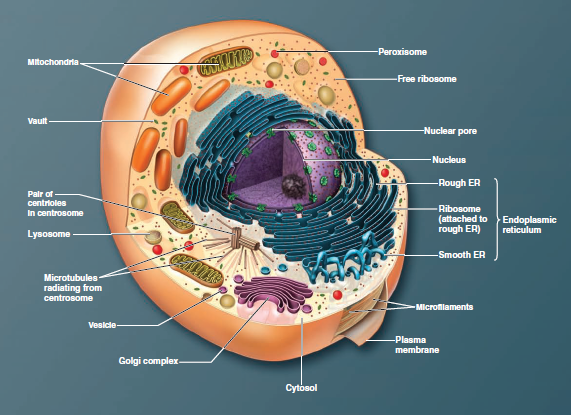
The Cell and Its Functions
The ability of cells to perform functions essential for their survival, in addition to specialized tasks that help maintain homeostasis within the body, ultimately depends on the successful, cooperative operation of the intracellular components. For example, to support lifesustaining activities, all cells must generate energy, in a usable form, from nutrient molecules. Energy is generated intracellularly by chemical reactions in the cytosol and mitochondria. In addition to being essential for basic cell survival, the organelles and cytoskeleton participate in many cells’ specialized tasks that contribute to homeostasis, for examples: Both nerve and endocrine cells release protein chemical messengers (neurotransmitters in nerve cells and hormones in endocrine cells) that are important in regulatory activities aimed at maintaining homeostasis and the ability of muscle cells to contract depends on their highly developed cytoskeletal microfilaments sliding past one another. Muscle contraction is responsible for many homeostatic activities, including (1) contracting the heart muscle, which pumps life-supporting blood throughout the body; (2) contracting the muscles attached to bones, which enables the body to procure food; and (3) contracting the muscle in the walls of the stomach and intestine, which moves the food along the digestive tract so that ingested nutrients can be progressively broken down into a form that can be absorbed into the blood for delivery to the cells. ■ White blood cells help the body resist infection by making extensive use of lysosomal destruction of engulfed particles as they police the body for microbial invaders. These white blood cells are able to roam the body by means of amoeboid movement, a cell-crawling process accomplished by coordinated assembly and disassembly of actin, one of their cytoskeletal components. keep in mind that proper cell functioning is the foundation of all organ activities.
At the end of lesson, students will be able to understand;
ORGANIZATION OF THE CELL
PHYSICAL STRUCTURE OF THE CELL
MEMBRANOUS STRUCTURES OF THE CELL
CYTOPLASM AND ITS ORGANELLES
CELL CYTOSKELETON AND ITS FUNCTIONS
CYTOSOL AND ITS COMPOSITION
NUCLEUS AND ITS COMPONENTS
FUNCTIONAL SYSTEMS OF THE CELL
MECHANISM OF EXTRACTION OF ENERGY FROM THE NUTRIENTS
CELL LOCOMOTION


